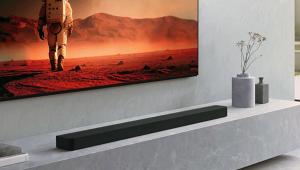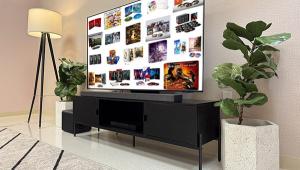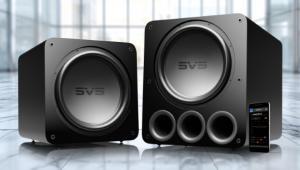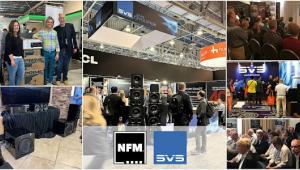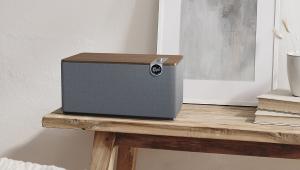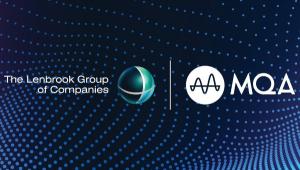First Listen: Dolby Atmos Is "Right" At Home Page 2
Onkyo and Pioneer both had active Atmos demos at CE Week. Onkyo used Triad-built Atmos speakers, set up on stands at the front and back of the seating area for their 5.2.4 Atmos System. Pioneer used their own just announced Elite speaker package designed by Andrew Jones, positioned very similarly. Unlike either the Triads or the prototype Onkyo speakers displayed in Onkyo's room, which used a single full-range driver on top, the Jones design fires up via the same new two-way concentric mid-tweeter driver that's used on the speaker's front baffle. Jones explained to me that, although a single full-range driver pointing up is Dolby's minimum spec, primarily to preserve space on the speaker top while achieving the required low-frequency range, a matching concentric driver in the same space should allow for a more cohesive soundfield.
I can't say I heard any significant difference between the two demos with the limited Atmos material on hand. Along with some impressive Atmos trailers designed to show off the technology that sounded about the same on both systems, the content provided by Dolby included a couple of clips from Life of Pi and another from Star Trek Into Darkness. Onkyo showed the big storm scene from Pi in which the cargo ship capsizes, while Pioneer demo'd the opening scene from Into Darkness in which Kirk and Bones are chased through a jungle by primitive, red-faced natives while Spock is dropped into the mouth of an erupting volcano. In both cases, surround effects were clearly coming from above me from places where I knew speakers did not exist, though I found the Life of Pi demo more convincing and exciting, a difference I attribute largely to how the films were mixed. Unquestionably, though, the ceiling-generated information added a dimension to the surround sound that was obvious and, to my ears, a notable enhancement.
So, What Could Be Bad?
About those caveats: although I'm excited by the potential of what I heard in the Atmos demos, if I were a typical consumer, I'd probably wait for the expert reviews before rushing out to preorder a full Atmos system. Some of that just comes from prudency that should be attendent to the introduction of any new technology. To begin with, it wasn't clear that either Onkyo or Pioneer were using one of their own receivers to decode the Atmos soundtrack, and although it's unlikely production AVRs would behave any differently than a professional decoder, I'd like to confirm that before passing judgement. Nor do we know yet just how much Atmos-encoded software will come to market, and what the new AVRs will do to make effective use of the extra ceiling channels when faced with a non-Atmos soundtrack from either Dolby or DTS.
More critically, I was a bit troubled by some of the subtleties of what I heard in both demo rooms, namely, the tendency for surround effects to be more localizable to the rear speakers than what I'm used to hearing in a well adjusted 5.1 or 7.1 system, particularly those that use dipole surrounds precisely to counter this common phenomenon. A lot of action seemed to be jumping at me from right off the speaker baffles behind me, and I soon realized why. In placing the Atmos surround speakers immediately behind the listening area, they were apparently optimized to best acheive an enveloping height effect. But that speaker position no longer best served the primary surround channels as well as a traditional side-wall arrangement might. And it also seemed to me to make the experience somewhat more dependent on listening position. For example, Onkyo's room featured two rows of seats, and when I leaned forward from the back row-center position during the demo to where the head of the listener in front of me might have been, I heard the localizing effect at the rear diminish slightly.
It's possible that small differences in set-up levels or other parameters could minimize this tendency for the rear effects to get sticky with the speakers, or that dipole designs that integrate the up-firing driver could help alleviate it, or that dedicated up-firing Atmos speakers could be installed separately at those positions that best deliver the ceiling effect while the side and possibly back surround speakers get to stay exactly where they do their own best work. Or, it's possible that a home theater with built-in ceiling speakers would deliver such a superior Atmos experience to any reflected installation that it's the only real option to be considered by the serious enthusiast. These are things we won't know until all the pieces come to market this fall and we can begin testing the different arrangements.
But in the meantime, I'm optimistic. From the minute I heard Atmos for movie theaters, I wondered how long it would take to bring it to home theaters. Now I know.
More Dolby Atmos News:
Dolby Atmos Movie-Theater-Sound Technology Heading to Home Gear
Pioneer Showcases Dolby Atmos-Enabled Receivers and Speakers






























